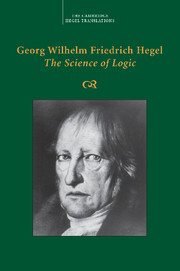Chapter 2 - Appearance
Published online by Cambridge University Press: 30 September 2021
Summary
Concrete existence is the immediacy of being to which essence has again restored itself. In itself this immediacy is the reflection of essence into itself. As concrete existence, essence has stepped out of its ground which has itself passed over into it. Concrete existence is this reflected immediacy in so far as, within, it is absolute negativity. It is now also posited as such, in that it has determined itself as appearance.
At first, therefore, appearance is essence in its concrete existence; essence is immediately present in it. That it is not immediate, but rather reflected concrete existence, constitutes the moment of essence in it; or concrete existence, as essential concrete existence, is appearance.
Something is only appearance – in the sense that concrete existence is as such only a posited being, not something that is in- and for-itself. This is what constitutes its essentiality, to have the negativity of reflection, the nature of essence, within it. There is no question here of an alien, external reflection to which essence would belong and which, by comparing this essence with concrete existence, would declare the latter to be appearance. On the contrary, as we have seen, this essentiality of concrete existence, that it is appearance, is concrete existence's own truth. The reflection by virtue of which it is this is its own.
But if it is said that something is only appearance, meaning that as contrasted with it immediate concrete existence is the truth, then the fact is that appearance is the higher truth, for it is concrete existence as essential, whereas concrete existence is appearance that is still void of essence because it only contains in it the one moment of appearance, namely that of concrete existence as immediate, not yet negative, reflection. When appearance is said to be essenceless, one thinks of the moment of its negativity as if, by contrast with it, the immediate were the positive and the true; in fact, however, this immediate does not yet contain essential truth in it. Concrete existence rather ceases to be essenceless by passing over into appearance.
- Type
- Chapter
- Information
- Georg Wilhelm Friedrich Hegel: The Science of Logic , pp. 437 - 448Publisher: Cambridge University PressPrint publication year: 2010

